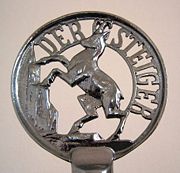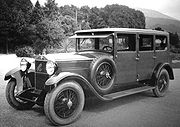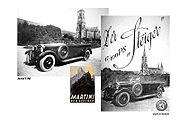.gif)
Steiger (automobile company)
Encyclopedia
The Steiger company was founded in 1914 as Maschinenfabrik (engine manufactory) Walther Steiger & Co. by the Swiss engineer Walther Steiger (1881–1943) in Burgrieden
near Ulm
, Germany. In 1921 it became a limited company (Steiger AG). During its short life the firm produced circa 3,000 vehicles.

 During the First World War the Steiger firm repaired aeroplanes and aeroplane engines. In 1917 the owner and his engineer, Paul Henze, began to work on motorized vehicles. Plans for the manufacture of tractors were abandoned in favour of the development of automobiles. Their first model, the Steiger 10/50 PS, was produced in 1920. This touring model with a 2.6 litre four cylinder engine (50 hp / 37 kW) became Steiger’s most significant product, and was still in production when the firm collapsed in 1926. Its modern OHC engine was distinctive because of an overhead camshaft driven by spiral-toothed bevel gear wheels. These cars, with ‘u’ shaped pressed steel frames, two axles with leaf spring suspension and a pointed radiator, were considered to be the most significant technical innovation of the early 1920s and the most progressive German serially-produced cars of their time.
During the First World War the Steiger firm repaired aeroplanes and aeroplane engines. In 1917 the owner and his engineer, Paul Henze, began to work on motorized vehicles. Plans for the manufacture of tractors were abandoned in favour of the development of automobiles. Their first model, the Steiger 10/50 PS, was produced in 1920. This touring model with a 2.6 litre four cylinder engine (50 hp / 37 kW) became Steiger’s most significant product, and was still in production when the firm collapsed in 1926. Its modern OHC engine was distinctive because of an overhead camshaft driven by spiral-toothed bevel gear wheels. These cars, with ‘u’ shaped pressed steel frames, two axles with leaf spring suspension and a pointed radiator, were considered to be the most significant technical innovation of the early 1920s and the most progressive German serially-produced cars of their time.
 In 1922 Steiger produced a two-seated roadster with a larger engine (cubic capacity 2.8 litres, 55 hp / 40 kW) that became available in 1924 as an even more powerful model (cubic capacity 2.9 litres, 70 hp / 51 kW). These types reached a maximum speed of 140 km/h (88 mph) (100 hp racing models could reach a speed of 180 km/h (113 mph)) and cost 18,000 Reichsmarks. Those high performance sports and racing models were very successful at racing events (Solituderennen
In 1922 Steiger produced a two-seated roadster with a larger engine (cubic capacity 2.8 litres, 55 hp / 40 kW) that became available in 1924 as an even more powerful model (cubic capacity 2.9 litres, 70 hp / 51 kW). These types reached a maximum speed of 140 km/h (88 mph) (100 hp racing models could reach a speed of 180 km/h (113 mph)) and cost 18,000 Reichsmarks. Those high performance sports and racing models were very successful at racing events (Solituderennen
, Avus
, Eifelrennen
, Klausenrennen
, Monza
and Targa Florio
) in the 1920s. In 1925 came the more powerful touring car, the Steiger 11/55 PS, with an extended wheelbase and the first sports car's engine.
At times the firm occupied up to 500 workers and employees. Despite their high class products that were often compared with those of Bugatti
, the firm went bankrupt in the wake of the 1926 automobile crisis.
 After the liquidation of his firm, Walther Steiger joined the Swiss automobile manufacturer Martini
After the liquidation of his firm, Walther Steiger joined the Swiss automobile manufacturer Martini
where he and his brother Robert had been the major shareholders since 1924. They produced a number of vehicles for Martini, including a 95 hp (70 kW) six-cylinder model. This luxury vehicle with a 4.4 litre engine appeared in Switzerland as Martini-Six and in Germany as 17/100 PS Steiger-Martini.
Following the pattern at Steiger, a number of different racing models were developed, and some achieved spectacular successes (twice reaching the first four in the 1929 Klausenpass race
, for example). But these carefully and individually manufactured models could not compete in the long run with cheaper, mass-produced vehicles from Germany, France and America. The end of a brand steeped in tradition was inevitable: on 12 June 1934 the last Martini left the factory in Saint-Blaise
on Lake Neuchâtel
.

Burgrieden
Burgrieden is a municipality in the district of Biberach in Baden-Württemberg in Germany....
near Ulm
Ulm
Ulm is a city in the federal German state of Baden-Württemberg, situated on the River Danube. The city, whose population is estimated at 120,000 , forms an urban district of its own and is the administrative seat of the Alb-Donau district. Ulm, founded around 850, is rich in history and...
, Germany. In 1921 it became a limited company (Steiger AG). During its short life the firm produced circa 3,000 vehicles.

The beginnings

A brief flowering

Solituderennen
The Solituderennen events and the 11.4 km Solitudering near Stuttgart were named after the nearby Castle Solitude. Motorsports events were held there from 1903 to 1965....
, Avus
AVUS
The Automobil-Verkehrs- und Übungs-Straße, better known as AVUS, is a public road that was also used as a motor racing circuit. It is located in the south-western districts of Berlin, Germany, between Charlottenburg and Nikolassee, and is nowadays an important part of the public highway system, as...
, Eifelrennen
Eifelrennen
The ADAC Eifelrennen was an annual motor race, organised by ADAC Automobile Club from 1922 to 2003, held in Germany's Eifel mountain region even before the Nürburgring was built there.- History :...
, Klausenrennen
Klausen Pass
Klausen Pass is a high mountain pass in the Swiss Alps connecting the cantons of Uri and Glarus. The pass road from Altdorf leads through the Schächen Valley, the pass and Urnerboden to Linthal in Glarus....
, Monza
Autodromo Nazionale Monza
The Autodromo Nazionale Monza is a race track located near the town of Monza, north of Milan, in Italy. The circuit's biggest event is the Formula One Italian Grand Prix, which has been hosted there since the sport's inception....
and Targa Florio
Targa Florio
The Targa Florio was an open road endurance automobile race held in the mountains of Sicily near Palermo. Founded in 1906, it was the oldest sports car racing event, part of the World Sportscar Championship between 1955 and 1973...
) in the 1920s. In 1925 came the more powerful touring car, the Steiger 11/55 PS, with an extended wheelbase and the first sports car's engine.
At times the firm occupied up to 500 workers and employees. Despite their high class products that were often compared with those of Bugatti
Bugatti
Automobiles E. Bugatti was a French car manufacturer founded in 1909 in Molsheim, Alsace, as a manufacturer of high-performance automobiles by Italian-born Ettore Bugatti....
, the firm went bankrupt in the wake of the 1926 automobile crisis.
Steiger-Martini

Martini (automobile company)
This is a page about the pioneer auto company. For the racing team, see Martini .Martini was a pioneer Swiss automobile manufacturer, in operation 1897 to 1934....
where he and his brother Robert had been the major shareholders since 1924. They produced a number of vehicles for Martini, including a 95 hp (70 kW) six-cylinder model. This luxury vehicle with a 4.4 litre engine appeared in Switzerland as Martini-Six and in Germany as 17/100 PS Steiger-Martini.
Following the pattern at Steiger, a number of different racing models were developed, and some achieved spectacular successes (twice reaching the first four in the 1929 Klausenpass race
Klausen Pass
Klausen Pass is a high mountain pass in the Swiss Alps connecting the cantons of Uri and Glarus. The pass road from Altdorf leads through the Schächen Valley, the pass and Urnerboden to Linthal in Glarus....
, for example). But these carefully and individually manufactured models could not compete in the long run with cheaper, mass-produced vehicles from Germany, France and America. The end of a brand steeped in tradition was inevitable: on 12 June 1934 the last Martini left the factory in Saint-Blaise
Saint-Blaise, Neuchâtel
Saint-Blaise is a municipality in the district of Neuchâtel in the canton of Neuchâtel in Switzerland.-History:Saint-Blaise is first mentioned in 1011 as Arins. In 1209 it was mentioned as Sanctus Blasus. The municipality was formerly known by its German name St Blasien, however, that name is no...
on Lake Neuchâtel
Lake Neuchâtel
Lake Neuchâtel is a lake in Romandy, Switzerland . The lake lies mainly in the canton of Neuchâtel, but is also shared by the cantons of Vaud, of Fribourg, and of Bern....
.
Steiger models

| Type | Production | Engine | Displacement | hp | Top speed |
|---|---|---|---|---|---|
| Steiger 10/50 PS | 1920–1926 | 4 R / OHC | 2604 cc | 50 hp (37 kW) | 95 km/h (60 mph) |
| Steiger Sport 11/55 PS | 1922–1924 | 4 R / OHC | 2826 cc | 55 hp (40 kW) | 128 km/h (81 mph) |
| Steiger Sport 12/70 PS | 1924–1926 | 4 R / OHC | 2902 cc | 70 hp (51 kW) | 140 km/h (88 mph) |
| Steiger 11/55 PS | 1925–1926 | 4 R / OHC | 2826 cc | 55 hp (40 kW) | 100 km/h (63 mph) |
See also
- Martini (automobile company)Martini (automobile company)This is a page about the pioneer auto company. For the racing team, see Martini .Martini was a pioneer Swiss automobile manufacturer, in operation 1897 to 1934....
– Saint-Blaise, Switzerland - auto motor und sport-tv: "Die faszinierendsten Autos der Welt – Klassiker", DVD (2002), EAN 4-260000-950484
Sources
- Hans-Heinrich v. Fersen (1): Autos in Deutschland 1920–1939. Stuttgart 1964.
- Hans-Heinrich v. Fersen, a.o. (2): Klassische Wagen 1919–1939. Cologne 1994, ISBN 3-8228-8944-X
- Ferdinand Hediger: Oldtimer – Interessante Automobile von 1885–1939. Berne 1982, ISBN 3-444-50134-X
- Helmut and Uta Jung: Stuttgarter Karosseriewerk Reutter. Bielefeld 2006, ISBN 3-7688-1829-2
- Ralf J.F. Kieselbach and Hans-Erhard Lessing: Faszination der Form – Automobildesign in Baden-Württemberg. Stuttgart, Weimar 2002, ISBN 3-476-01825-3
- Werner Oswald: Deutsche Autos 1920–1945. Stuttgart 1982, ISBN 3-8794-3519-7
- Michael Schick: Steiger – Die Geschichte einer schwäbischen Autofabrik in den 20er Jahren. Laupheim 1999, ISBN 3-00-003913-9
External links
- http://www.steiger-burgrieden.de
- http://www-lenya.nzz.ch/klausenrennen/rangliste/rangliste-1923.html
- http://www-lenya.nzz.ch/klausenrennen/rangliste/rangliste-1929.html

